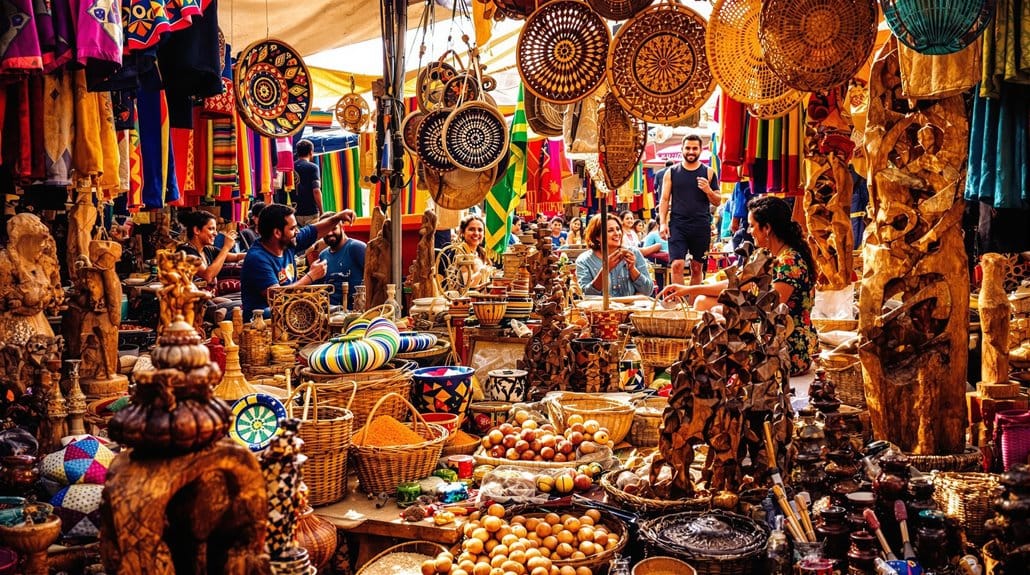You might think traditional African crafts are just for tourists, but they embody deep cultural narratives that deserve broader recognition. As you explore the vibrant markets and intricate artistry, you'll find that each piece tells a story shaped by centuries of tradition and innovation. Yet, artisans often struggle against various obstacles that limit their potential. What if there were ways to not only support these creators but also to elevate their crafts on a global stage? Understanding the dynamics at play can open doors to new opportunities you might not have considered.
Key Takeaways
- Understand the global demand for handmade products, particularly in the U.S. sustainability market, to better position African crafts.
- Leverage e-commerce platforms to gain direct access to international markets and enhance visibility for traditional crafts.
- Focus on quality and cultural authenticity to counter the perception of low-quality crafts and elevate market recognition.
- Collaborate with designers and utilize digital storytelling to attract conscious consumers seeking ethically made products.
- Advocate for fair trade practices to ensure equitable compensation and support sustainable growth for local artisans.
Overview of African Craft Industry
In the vibrant tapestry of the global economy, the African craft industry stands out as an important contributor, valued at an impressive $32 billion in 2020. This sector flourishes with traditional African art that reflects the continent's rich cultural heritage, offering unique home décor that resonates with global consumers.
As you explore these handmade treasures, you'll see that each piece tells a story, connecting you to the artisans behind them.
Approximately 60% of these handmade products find their way to markets in the US and EU, showcasing the high demand for African crafts. With the US sustainability market projected to reach $150 billion in 2023, there's a golden opportunity for ethically made African crafts to thrive.
By choosing these products, you not only enhance your living space but also support local artisans who contribute greatly to their communities.
However, the perception of these artisan businesses as low-quality remains a challenge. Elevating the status of African crafts is essential to recognizing their true value as economic drivers.
Challenges for Artisans
Many artisans across Africa face formidable challenges that hinder their potential for growth and market access. Limited access to financing severely restricts your ability to scale operations and reach international markets. When you struggle with marketing and logistics, competing globally becomes an uphill battle, affecting your sales and visibility.
To paint a clearer picture, consider the following table:
| Challenges | Impact on Artisans |
|---|---|
| Limited access to financing | Hinders growth and expansion |
| Marketing and logistics issues | Reduces global competitiveness |
| Lack of market intelligence | Misalignment with consumer preferences |
| Perception of low-quality crafts | Undermines recognition and support |
Women artisans often face compounded challenges. Systemic barriers limit their access to funding and training, while competition from mass-produced alternatives makes it even harder to survive. This situation creates a cycle that stifles creativity and economic contribution, leaving many talented artisans struggling for recognition. By understanding these challenges, you can better appreciate the resilience and potential of African artisans, fostering a sense of belonging and support in your community.
Technology's Role in Support
Harnessing technology can revolutionize the way African artisans connect with the global market. By leveraging digital tools, you can enhance communication and streamline payment processes, making your operations more efficient.
E-commerce platforms open the door to international markets, allowing you to showcase your handmade products directly to a global audience enthusiastic for ethical products.
Here are some ways technology supports artisans like you:
- E-commerce Opportunities: Sell your creations online, reaching customers who value unique, handmade items.
- Remote Collaborations: Partner with other artisans to create diverse collections, expanding your offerings beyond traditional crafts.
- Digital Storytelling: Use platforms to share your brand narrative, increasing your visibility and attracting conscious consumers.
- Successful Models: Learn from tech-driven organizations like Soko, which empower artisans by enhancing production capabilities and market competitiveness.
With technology in your toolkit, you're not just preserving traditions; you're transforming them into viable, sustainable businesses that resonate with a global audience.
Embrace these innovations, and watch your crafts flourish in ways you never imagined.
Opportunities for Growth
The immense potential for growth within the African craft sector presents a unique opportunity for artisans like you to thrive. With the global art market valued at $32 billion, there's a significant demand for beautiful handmade products. As the U.S. sustainability market is projected to hit $150 billion in 2023, you can capitalize on this trend by creating ethically made crafts.
Technology plays a crucial role in your growth, facilitating communication and e-commerce, enabling you to reach customers worldwide. Collaborations with designers can elevate your product appeal while maintaining the rich cultural heritage of your craft. Adopting fair trade practices guarantees you receive equitable compensation, fostering a sustainable artisan economy.
Here's a quick overview of the opportunities available:
| Opportunity | Benefits | Action Steps |
|---|---|---|
| Market Expansion | Reach global customers | Utilize e-commerce platforms |
| Ethical Products | Align with consumer demand | Emphasize fair trade practices |
| Collaborations | Enhance product visibility | Network with designers |
| Technology Utilization | Streamline operations | Invest in digital tools |
| Cultural Preservation | Maintain authenticity in designs | Incorporate traditional techniques |
Embrace these opportunities for growth and watch your craft flourish.
Future Vision for Crafts
With a growing appreciation for artisanal craftsmanship, the vision for African crafts is shifting towards establishing them as premium goods in the global market. This transformation emphasizes the cultural richness and intricate artistry behind each piece.
You'll witness a future where African crafts thrive alongside contemporary African art, celebrated for their vibrant colors and unique narratives.
To achieve this vision, consider the following key factors:
- Quality Over Quantity: Elevate the perception of African craft from low-quality trinkets to sought-after artisanal goods.
- Savvy Business Practices: Equip artisans with the skills to navigate evolving market trends and consumer demands, focusing on sustainable production methods.
- Cultural Integration: Guarantee that artisan production fits within global supply chains while preserving traditional techniques.
- Fair Trade Practices: Advocate for equitable compensation, fostering a sense of community and belonging among artisans.
Frequently Asked Questions
What Is a Traditional African Craft?
A traditional African craft blends beadwork significance, pottery techniques, textile patterns, carving styles, and basket weaving. These art forms reflect community identity and heritage, fostering a sense of belonging and connection to cultural roots.
Is There a Market for African Art?
Yes, there's a vibrant market for African art, reflecting cultural significance and modern influences. Global appreciation is rising, driving economic impact and expanding opportunities for artists, making it an exciting time to engage with this dynamic scene.
What Are the Four Main Art Themes in Africa?
When it comes to African art, you're diving into a rich tapestry. The four main themes are cultural symbolism, spiritual significance, regional diversity, and contemporary influences, all showcased through various artistic techniques that reflect deep-rooted traditions.
What Are the Characteristics of Traditional African Art?
Traditional African art showcases material diversity and regional variations, emphasizing artistic techniques that convey cultural significance. Each piece carries symbolic meanings, deeply rooted in community values, storytelling, and the rich heritage of diverse African cultures.
Conclusion
In exploring traditional African crafts, you'll discover a world rich in culture, creativity, and potential. Embrace the challenges artisans face, celebrate the technology that supports them, and seize the opportunities for growth that lie ahead. By championing quality, sustainability, and fair trade, you can help elevate these unique crafts to global recognition. Together, we can forge a future where African artistry thrives, where stories are shared, and where every piece resonates with the heart of its heritage.








